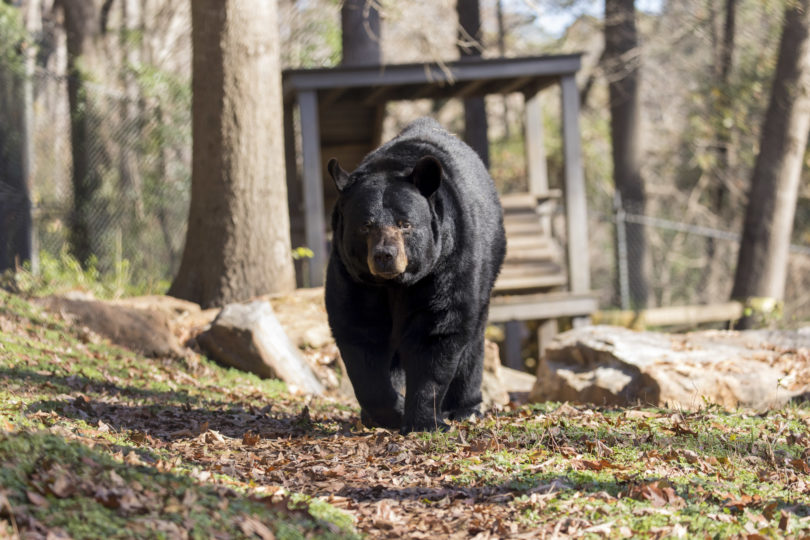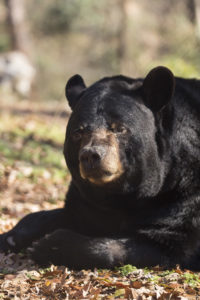Once a year, Dr. Joerg Mayer, associate professor of zoological and exotic animal medicine at the University of Georgia’s College of Veterinary Medicine, takes a group of students out to Bear Hollow Zoo to perform an annual bear checkup.
The checkup typically takes place a month or so before the bears hibernate for winter and a lot of preventive medicine happens during this exam, according to Mayer. So what exactly is involved in this annual exam?
- Anesthetize the bear. The first step of the checkup is anesthetizing the bear. Because bears are dangerous, they must be completely knocked out for the checkup. Mayer said the bear is typically out for three or four hours. “With a dog or a cat, you don’t need to do this,” said Mayer. “Even a dangerous dog can just wear a muzzle. But you can’t put a muzzle on a bear.”
- Perform an ultrasound. Bears have a fairly high rate of liver cancer, particularly in captivity, explained Mayer. “One reason is that they grow so much older in captivity than they do in the wild,” he said. An ultrasound can detect early signs of liver problems. “If you see clinical signs that they are going off of their food or slowing down, it’s too late by then,” said Mayer. “That’s why we check them once a year.”
- Scan bloodwork. This scan includes looking at the white blood cell count and the liver and kidney values. “If we see a trend that every year the values are getting higher [which is not a healthy sign] then it’s on our radar. Maybe we switch the nutrition around. Maybe we decrease protein or add more fish for omega-3s. That’s the whole idea of these yearly checkups,” said Mayer. This is part of the blood work: Check the bone marrow — “We make sure it’s still working as it’s supposed to. If you have a 2-year-old bear you’re not as worried as you are with a 12-year-old bear,” said Mayer.
- Check teeth. The students perform a dental exam during the checkup to look for tartar buildup or fractured teeth. Sometimes bears fracture their teeth by gnawing excessively. “They might be bored or not as mentally challenged as they would be in the wild because they are safe and have food so they don’t have to worry about anything,” said Mayer. “If they become bored, they can develop stereotypic repetitive motions, like pacing, and sometimes they bite a rock or something like that and break off a tooth.” Mayer said Bear Hollow keeps its bears mentally engaged. “They hide things for DJ to find, sprinkle food in different places and put honey on a tree trunk or feed him live meal worms. That way the bears have to use their noses to find the food. We don’t see stereotypic behaviors in these bears and that’s because they’re doing a really good job at Bear Hollow.” DJ also has excellent teeth because he loves acorns. “I think the husk and shells work like a toothbrush and scrape off the leftovers and bacteria that cause the tartar,” said Mayer.
- Take a radiograph. Every other year, Mayer’s team of students radiograph the bear to check for any arthritic changes or other potential problems in the joints and the bones. However, if a bear shows signs of being lame, a radiograph is performed right away. During this portion of the exam, students also check range of motion in the bear’s joints. They listen for clicking sounds in order to make sure there are no bone spurs or evidence of arthritis.
- Check the eyes and ears.
- Scrape the skin for parasites. “Bears live outside and other mammals like squirrels, raccoons or skunks come into the exhibit so there is always a chance of getting mites, fleas or other acquired dermal problems,” explained Mayer.
- Give him a dewormer and do a fecal exam.
- Palpate his belly. The students do this to ensure there are no masses by manually palpating and checking the organs.
- Give fluids for support after anesthesia.
DJ, who is 16 and approaching bear middle age, got a clean bill of health during his annual checkup, which is good news. American black bears can live up to age 40, but 20 is more typical. The average in the wild is 18 years.
The students who participate in this annual bear checkup are getting a unique experience. “Not many people get to be part of a medical team that handles a bear,” said Mayer, who encourages them to apply the knowledge they’ve already gained at UGA working with cats and dogs.
“I tell them to think of DJ as a big dog. You need two hands to palpate a bear, for example, whereas you usually only need one hand for a dog. Other than that the medical knowledge isn’t that different.”
Mayer also encourages the students to think ahead more with a bear. “With a dog, you can take blood and call the owner tomorrow. With a bear, you only want to anesthetize once, so any problems should be addressed on the same day. You only have hands-on with these zoo animals once a year. Otherwise we use observation. We want to be on top of it before the animal shows signs of disease.”







